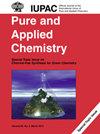3-(4-methoxyphenyl) acrylic acid halts redox imbalance and modulate purinergic enzyme activity in iron-induced testicular injury
IF 2
4区 化学
Q3 CHEMISTRY, MULTIDISCIPLINARY
引用次数: 0
Abstract
Various derivatives of cinnamic acid have been reported to possess significant activities such as antioxidant and hepatoprotective, and neuroprotective activities. Interestingly, testicular toxicity has been linked to several causes, with oxidative damage being one of the pathophysiological mechanisms. 3-(4-methoxyphenyl) acrylic acid (1), a derivative of cinnamic acid, was synthesized and then investigated for its effects on iron-induced testicular injury and oxidative stress via3-(4-甲氧基苯基)丙烯酸在铁诱导的睾丸损伤中阻止氧化还原失衡并调节嘌呤酶活性
据报道,肉桂酸的各种衍生物具有显著的活性,如抗氧化、保肝和神经保护活性。有趣的是,睾丸毒性与多种原因有关,其中氧化损伤是病理生理机制之一。我们合成了肉桂酸的衍生物 3-(4-甲氧基苯基)丙烯酸(1),然后分别通过体内外研究和硅学研究考察了它对铁诱导的睾丸损伤和氧化应激的影响。对 KAD-1 的 FRAP、DPPH 自由基清除活性和铁螯合潜力进行了评估。通过将组织上清液和 0.1 mM FeSO4 与不同浓度的 1 在 37 ℃ 下孵育 30 分钟,诱导睾丸氧化损伤处理。与标准槲皮素相比,随着浓度的增加,1 的清除性能显著增加(p < 0.05)。诱导睾丸损伤时,MDA、CAT、ATPase 和 ENTPDase 活性降低(p < 0.05)。30 mg/mL处理组的MDA水平最高。观察到 GSH 水平和 SOD 活性明显上升。结果表明,1 具有防止睾丸氧化毒性的潜力,这体现在它能够控制核苷酸水解和减少氧化应激。总之,这项实验研究的结果表明,3-(4-甲氧基苯基)丙烯酸(1)可用于预防氧化性睾丸功能障碍。因此,3-(4-甲氧基苯基)丙烯酸(1)将是开发缓解男性不育症药物的好产品。
本文章由计算机程序翻译,如有差异,请以英文原文为准。
求助全文
约1分钟内获得全文
求助全文
来源期刊

Pure and Applied Chemistry
化学-化学综合
CiteScore
4.00
自引率
0.00%
发文量
60
审稿时长
3-8 weeks
期刊介绍:
Pure and Applied Chemistry is the official monthly Journal of IUPAC, with responsibility for publishing works arising from those international scientific events and projects that are sponsored and undertaken by the Union. The policy is to publish highly topical and credible works at the forefront of all aspects of pure and applied chemistry, and the attendant goal is to promote widespread acceptance of the Journal as an authoritative and indispensable holding in academic and institutional libraries.
 求助内容:
求助内容: 应助结果提醒方式:
应助结果提醒方式:


